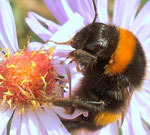Beekeeping for beginners
If you pick the right swarm, bees can give you lovely honey and provide a pleasant new element to your garden


Each hive is made up of a queen, a couple of hundred male bees (‘drones’) and about 50,000 female bees – who are the ‘workers’. It is the females that you are likely to see around the garden, as they collect pollen to take back to the nest.
The queen bee is recognisable as she is slightly larger than the workers. She lives for roughly three years, and in that time will lay about half a million eggs. After each crop of eggs has hatched she will fly from the nest, mate with about six or seven drones (who will subsequently die) and return to her workers.
When buying a hive, the most aesthetically pleasing option is the traditional, white ‘WBC’ hive, which is named after William Broughton Carr, who first published the details of the hive in ‘The Bee Journal and Record’ in 1890. An easier option though is the ‘National’ hive, which is a basic square brown box that is very straightforward to use.
As far as other ‘kit’ is concerned, avoiding stings is a priority, and although experienced beekeepers can check the hive without a suit or indeed the need for smoke, a bee-suit is a must for beginners. Opt for an all-in–one suit, with a veil, and combine it with a sturdy pair of thick gloves, and some tough, durable wellies. (All this should not set you back more than £150, as a guideline.)
Smoke is used to pacify the bees, as they associate it with fire, and therefore concentrate solely on eating their honey, before it gets burnt. You need a ‘smoker’, to spread the smoke around the hive as you work, as well as a ‘hive tool’, which will help you to prise apart the different sections of the hive, without damaging them.
When looking for the bees themselves, try your local beekeepers’ association, to see if there are any for sale nearby – do be aware though that they must be taken more than * miles from their current home, or they will simply swarm and make their way back. There are also bee auctions, generally held around May or June time. For more information about these see www.bee-craft.com or www.beekeeping.co.uk When choosing your bees be sure to pick a docile swarm, as they will be obviously far easier (and less painful!) to handle. New Zealand bees, for example are darker in colour to our own native bees, but are generally very good-natured. Colonies differ hugely from one another though, so if in doubt, ask their current keeper for one that will be easy to handle.
The bees generally do not need too much attention, and can survive very happily without your help. They do however need checking in the spring-time, and as it begins to warm up it is a good idea to clean away any debris that has built up over the winter, such as dead bees or cobwebs. Replace any broken frames, and most importantly check that your queen is laying eggs, and that there are enough honey stores for the bees to live on, before you begin to take any away for your own honey.
Exquisite houses, the beauty of Nature, and how to get the most from your life, straight to your inbox.
Through spring up until around July time the colony will continue to expand, and to avoid them swarming to find a new home, you need to make sure that there is enough room in the hive for them to lay eggs and store honey. If space starts to become scarce, the queen is likely to leave the hive to form another colony. If she does this then some workers will follow her, while about half will generally stay behind and make a new queen, but you will of course lose half of your overall colony and therefore not get as much honey.
The best time to start collecting the honey is August, as most flowers will have bloomed. Everything that you take away needs to be replaced in the autumn, with sugar solution, which the bees can eat in order to survive through the winter. Be aware of unwanted scavengers and stowaways during the colder months, such as mice and woodpeckers. The bees can then be left to sleep in peace until spring!
For more information or advice contact a local branch of The British Beekeepers' Association
Country Life is unlike any other magazine: the only glossy weekly on the newsstand and the only magazine that has been guest-edited by His Majesty The King not once, but twice. It is a celebration of modern rural life and all its diverse joys and pleasures — that was first published in Queen Victoria's Diamond Jubilee year. Our eclectic mixture of witty and informative content — from the most up-to-date property news and commentary and a coveted glimpse inside some of the UK's best houses and gardens, to gardening, the arts and interior design, written by experts in their field — still cannot be found in print or online, anywhere else.
